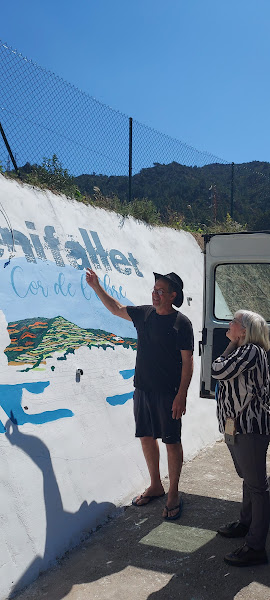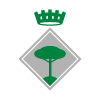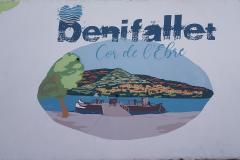Els Passos de Barca de l'Ebre (Ebro's river crossing sides)
The Benifallet boat had a significant importance for the municipality until the construction of the Llaguter bridge in 1991. Honoring it and highlighting the prominent role it played both in the economy and in the daily life of the people is the aim of the mural that has been designed to the left bank’s boat step. In memory we recover a space that contributes to the belief of the rich in our town, from a fundamental sector such as tourism.
A tourism that gives relevance to its heritage. The mural is the work of the English artist, internationally recognized for his technique Reverse, Paul Curtis. https://setmanarilebre.cat/paul-curtis-i-la-seua-tecnica-reverse-graffiti-que-vol-conquerir-les-terres-de-lebre/.
The space recovery project is supported by IDECE. In this entry, you can find linked information about both IDECE, which is responsible for navigation in our territory, and the steps that are still in operation, the Miravet, the Garcia and the Flix.


RIVER CROSSING SIDE OF BENIFALLET
The function of the PAS DE BARCA had been and was for centuries the means to connect both sides of the river, either to move towards some town or especially the passage of peasants, animals and vehicles that were going to the cultivation of the lands on the other side of the term.
The barge was held down by a pulley that passed through the gúmena, which in the past could be a rope made of hemp or pita. In each boat there was a boatman who was an expert in river affairs and worked from sun to sun. Although it was usually done by the travelers themselves, the ferryman was in charge of tying and untying the boat to the jetties, called bridges, which with a system of chains could be raised or lowered according to the oscillation of the river level . At the end of the pier overlooking the river were two hooks, where the boat was tied by ropes or chains carried by the boat.
The boats were formed by two llaguts, between 25 and 35 tons, placed parallel and separated by a distance of about three meters. Above it was installed a square wooden platform made of planks. The planks were fixed together with iron handrails and then the platform was embedded on the edges of the hull of the llagut.

The last three llaguts of the Benifallet Barge were:
1. The llagut SAN JUAN (only survivor of the llaguts before the Battle of the Ebro), built in 1933 and owned by Jaume Gabriel Trilla, neighbor of Benifallet. It weighed 13.35 tons and about 17.75 meters in length, 2.73 in beam and 1.08 in strut. It had been built in Tortosa by the calafate José Sánchez Curto and had cost 18,000 pesetas. In the late 1990s it unsuccessfully attempted to recover it from the river for restoration, but it was eventually damaged.
2. The llagut CARDENAL is not known of the year of construction, but it is known that after the inauguration of the Pont del Llaguter was sold to the General Council of Aragon. The latter, as owner ultimately after she ceded it to the Faió City Council in 2007, where she still continues her work today across the river. It weighs 14 '13 tons and measures 18'68 meters in length, 2 '82 in beam and 1' 05 in strut. It was built in Tortosa by the calafate José Sánchez Curto and cost 12,000 pesetas.
3. The CLAYRE llagut is not known of its date of construction or its sizes, but it was bought together with the Cardinal by the Benifallet City Council for the modernization of the Pas de Barca. Some sources suggest that it is sunk in the river, which is, it is explained, the traditional way of preserving a boat.


RIVER NAVIGATION. THE LLAGUTS
The footprint that the Ebro has left on the land of Benifallet has marked the history of our people which is one of the references when we talk about the trade of llaguter and ferryman.
The Ebro River has been a major route of communication for thousands of years, an extension of the maritime routes of the Mediterranean, a commercial and military road towards its interior until well into the 20th century. The most used system to climb the river is the tow. The pattern, located at the stern, holds the rope called a scintilla or tow which, passing through the top end of the mast, ends with the tower. It takes a lot of mast height to save the reeds, riverside trees and other obstacles that stand between the towpath and the boat. In addition, a large length of rope is needed to pass through the numerous places where the bottom of the river forces to pass through points very distant from the shore where the road is traced. "When the tow is made with men, each one receives a special name: the striker, called Daliner, is helped with a cane called dalín and the shoulder is protected with wooden trellises; in the case of two towers, the second is called dragger or zaguero; when they are more, the second is called donkey knot and has never been recorded more than four sirers. When a mule is used, it needs one to two hmas to be cared for. It is hard work because of the bad roads and the reeds or shrubs that populate the banks" (Carreras Candi, 1993:317).

Francesc Cost explains in his book Benifallet between two centuries that "To be able to tow, one of the essential things that there was was that necessarily, along the river and in the same song of the bank, a path had to be respected by those who made the tow, whether they were prisons or animals. The landowners could not put any impediments or obstacles, and the llaguters took care, on their own, to keep it clean." The journey up the river required the towing of llaguts. Therefore, as we have explained an encounter, and more ancient llaguteres, stretched the llagut along the towpath. "The tllagu was held by the gúmena, but to make it advance when there was not enough current, to do it alone thanks to the position of the rudder there were some long wooden bars with an iron toe at the end because they did not wear out: then, men of better will took them, one before and the other behind; as there was no law that indicated who should take them, there was always a living one who tried to escape it" (Francesc Cots, Benifallet between two centuries).

The Llaguts were the last river transports of goods. Of artisan construction of wood, made by the masters of riverside in the shipyards, they had an average dimensions of about 20 meters in length, 2.3 meters wide and just about 12 cm in size. They could transport about 30 tons of drop and about 10 tons of rise. The river was rarely sailed and most of the time was made from the Sirga Road with the towers formerly and then with a male guided by a man "the machero". Llaguts sailed through the waters of Benifallet such as Nueva España, Caragirat, Cara Negra and Pirata, along with Mari Juana and Jose Ramon, of the Blanquet, and San Juan, of the Banyot.
The development and improvement of the land transport network, and the construction of the Ribarroja and Mequinenza reservoirs, led to the definitive disappearance of commercial river navigation in the late 1960s. However, Benifallet kept a passing boat until 1991.

THE BRIDGE OF THE LLAGUTER
With the construction of the Llaguter Bridge of Benifallet, on the axis of the Ebro, the communicative comfort of the town with the rest of neighboring villages. The Llaguter represented a before and after for the people, which until that moment was very badly communicated by road, through the pass of Som, with Tivenys and Tortosa. The Ebro axis and the Llaguter bridge opened the town in the rest of the region, and also in the Terra Alta and the Ribera d'Ebre. It became a key element of road communication not only for Benifallet but for the whole of the Terres de l'Ebre.
The bridge is 231 meters long, has three eyes of 68,5m, 94m and 68,5 meters. Built with 96 pieces, with prefabricated voussoirs, technically it is hyperstatic, of variable inertia. The axis of the bridge is a curve and counter curve. The work, directed by the engineer Manuel Reventós i Rovira, had a cost of 758,034,395 pesetas, financed by the Generalitat de Catalunya (613,034,395 pesetas) and the Diputación de Tarragona (145,000 pesetas). The bridge began construction on 10 May 1987 and was inaugurated on 23 February 1991.
On the occasion of the inauguration of the bridge was erected the Monument to the Llaguter, work of Clari. It is in the words of the Benifalletense writer Francesc Cots "the tribute of a people and a land that does not forget the work and effort of the last navigators of the Ebro".
Monument of the LLAGUTER
Located at the crossroads of the Ebro, painted by Clari, it is, as the poem of the local writer Francesc Cots says, the "homage of a village and a land that does not forget the work and effort of the last sailors of the Ebro".






